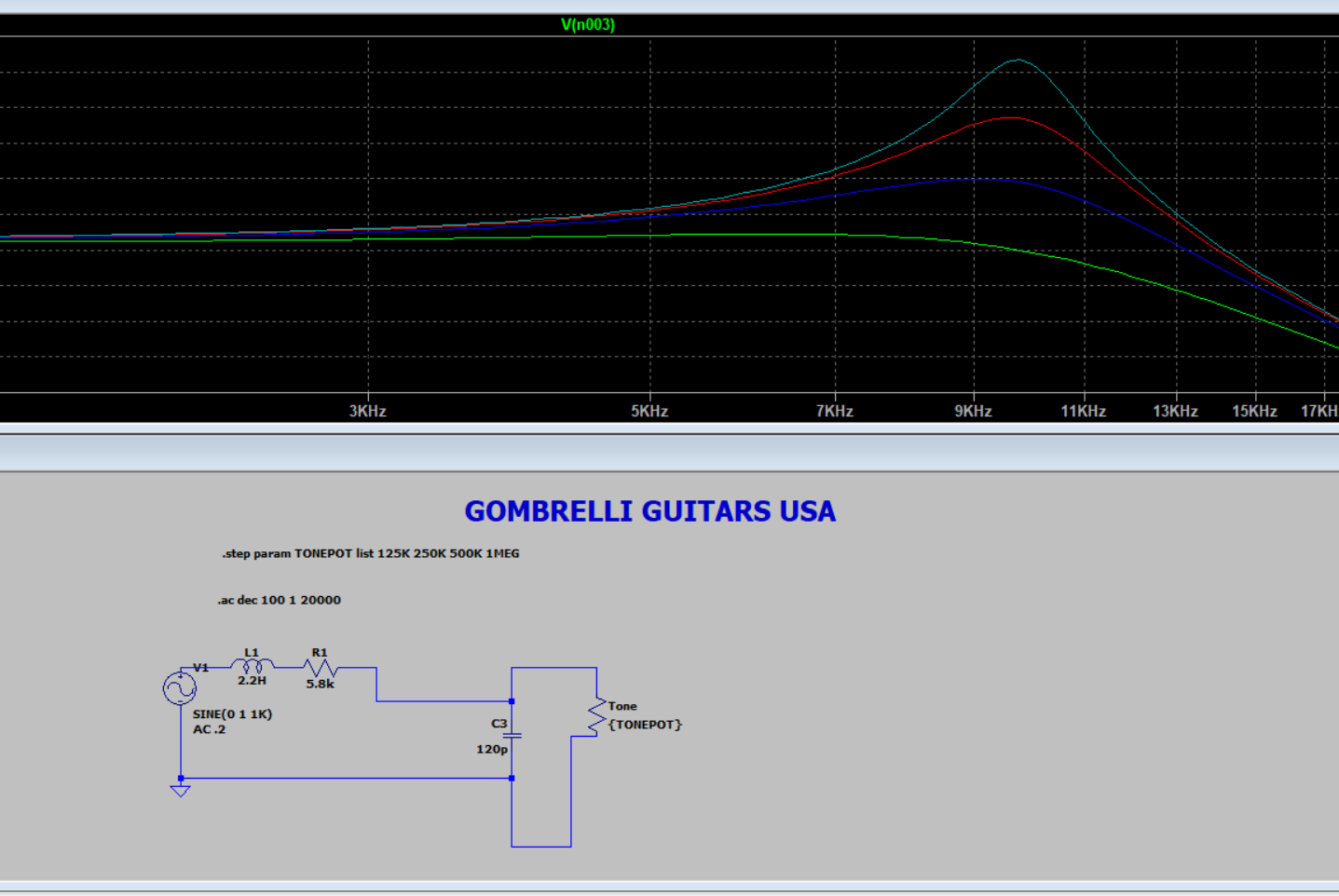by Bruce Baker Gombrelli 2023.07.20
I see comments all the time about the difference that the volume pot (and tone pot) values make on the sound of the pickups.
Is it true?
The short answer: Yes!
I put together a simple graph of a circuit modeled pickup to illustrate what is occurring. When a pickup is “unloaded” it has a frequency notch and a Q (Q is the width of that notch). Unloaded it’s rather sharp with a tight Q. The notch depends on a lot of factors including the DCR, The Inductance, the Stray Capacitance, eddy currents and other minor effects. But for illustration the DCR and inductance is an easy reference that pretty accurate as a notch indicator.
In general:
Humbuckers have a bigger Q, Trend toward higher DCR values and a lower frequency notch. High Output single coils and stacked coils also have lower frequency notches and larger Q values. Low wind pickups and vintage pickups tend to have a lower inductance have higher Frequency resonance notch.
LOADING
When a pickup is loaded it widens the Q, Lower the frequency Notch, Lowers the peak and smooth out the frequency response of a pickup.

The Circuit: The model above is a 57/62 Fender Pickups *measured”, the equivalent cap value and a volume/tone pot (I combined them in parallel so you just see one). What I didn’t include was any pedal or amp loading and for the sake of this model assume your pedal or amp is of Hi Z input so we are measuring directly the output of the Stratocaster without being plugged in. Further assume the volume is on full and the tone is full on.
The Graph
In the above graph is the output for 4 different values. represents a vintage single coil (57/62) with 4 different loads. 125K (two – 250K Pots vol and tone) – Green — 500K Tone and Volume which in parallel is 250K, and then a 1 Meg Vol and Tone is the red curve. And a light blue line which pretty much seems unloaded using 2 – 2 meg pots and volume (never used)
Results
What you might not realize is that the SHARP upper peak of the 1 meg vol/tone is actually not a good sound, it’s shrill and it not very balanced tonally. You would hear that as shrill, sharp and uncomfortable. The BLUE curve has much slighter notch. It may seem a bit bright but would be palatable a little. The GREEN curve is almost flat with a drop off. In practice there would be a slight notch which would be the dominant characteristic of that particular pickup. (Keep in mind the position neck/middle/bridge also affect the perceived tone for reason to detailed to get into here.)
If you change it to a Humbucker (no curve for that above), just image the notch would be lower and wider to start with. For example, the blue curve would be flatter with a lower frequency notch that is why the larger pot works well for giving a higher output pickup a bit more sparkle and why 500K to 1Meg pots were used with Stacked coils.
Fender went as far as to use a GANGED dual pot arrangement on the older Standard HSS guitar when the humbucker ran though the 500K and the 2 single coils were wired with a 250K pot. It also used a 250K for the middle neck and a 500K for the humbucker tone. They moved away from this later although I still rather thought it was a great arrangement, but it was much more complicated to wire so that probably drove them away from it.
The best match for most vintage single coils is always 2 – 250K pots, High output single coil, stacked coils (unless vintage stacked) and humbuckers like 500K pots and even 1 Meg on some very high output pickups and some stacked coils.
This is also why, when matching with single coils you generally don’t want a vintage coil matched with a big fat humbucker, because neither one is going to be in their sweet spot, 250K being too small for the big bucker and 500K+ being a bit to beefy for the single coil making it more thin and shrill. However, matching single coils with vintage buckers will work ok with two 250K pot, I like to edge those up and use 300K pots myself to get the best of both worlds. Another way is to make the volume 500K and the tone 250K, that gives a parallel resistance of about 175K ish which help the bucker have a bit more top end punch but doesn’t drive the single coil resonance too high.